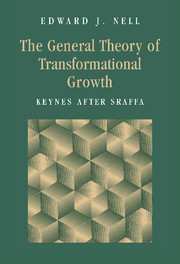Book contents
- Frontmatter
- Contents
- Preface
- Acknowledgments
- Part I History or equilibrium?
- Part II Method and approach: the active mind
- Part III Money and the Golden Rule
- PART IV The wage-profit trade-off
- Part V Investment and Mass Production
- Part VI Money and fluctuations in the modern economy
- Conclusions
- 14 Keynesian themes on Classical grounds
- Bibliography
- Index
14 - Keynesian themes on Classical grounds
Published online by Cambridge University Press: 21 January 2010
- Frontmatter
- Contents
- Preface
- Acknowledgments
- Part I History or equilibrium?
- Part II Method and approach: the active mind
- Part III Money and the Golden Rule
- PART IV The wage-profit trade-off
- Part V Investment and Mass Production
- Part VI Money and fluctuations in the modern economy
- Conclusions
- 14 Keynesian themes on Classical grounds
- Bibliography
- Index
Summary
It's been a long journey. We've covered a lot of ground, but, hopefully, we've climbed a peak, giving us some perspective to see around us, and assess what we've accomplished.
We began with History. Economics based on rational choice does not have much of a place for history. If rationality is the same always and everywhere, all History can do is shift the constraints and incidental circumstances. Markets, fundamentally, will always be the same. Not much room for Evolution.
However, basing the theory of market equilibrium on rational choice involves a philosophical mistake, a confusion of prescription with description. Rational choice – optimizing – has a place in economics, but not in the service of equilibrium. It is a tool to be used in pursuit of innovation. To situate innovations, to understand the forces generating them, it is necessary to have a picture of the structure of the system, at the basis of which lies technology. Technology, in turn, responds to incentives, which the market generates plentifully. Hence we have evolutionary pressures driving the development of markets, and market institutions – Transformational Growth.
These pressures will be expressed in monetary terms. To understand them we will need to know how the monetary system works. And this brings us face to face with our title: just what do we mean, calling our theory Keynes after Sraffa?
- Type
- Chapter
- Information
- The General Theory of Transformational GrowthKeynes after Sraffa, pp. 717 - 746Publisher: Cambridge University PressPrint publication year: 1998



